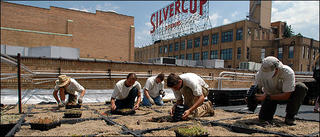In what turns out to be an oddly inspiring article, we read about the green-roofing of New York City and Chicago.

Green-roofing – really just planting a garden on your roof – is – well, just read the article: “The carefully selected plants and soil – engineered to weigh only a fifth as much as typical dirt – help clean the air and absorb rain that would otherwise become storm-water runoff. And when many of them are clustered together, green roofs can reduce the urban heat island effect (densely populated cities tend to be hotter than surrounding areas because of the heat-trapping properties of tall buildings, asphalt and concrete).”
In other words, they’re anti-parking lots.
They’re the *ne plus* of the *ultra* for the world of urban car park management.
In any case, “‘Isolated green roofs are expensive insulation,’ Ms. Hoffman [executive director of Earth Pledge] said. ‘But when you have a whole community of green roofs, it changes the microclimate of the area and reduces demand for energy.'”
Microclimates!
Because of such efforts elsewhere, not only does Chicago’s City Hall have a green roof – the first municipal building in the city to do so – but in Long Island City roof gardeners are now at work: “A matrix of 1,500 planters will have 20 different species of plants intended to show off their red, yellow and green colors, visible from the Queensboro Bridge when in full bloom.” After all, “Long Island City has 667 acres of empty flat-roof surfaces suitable for vegetation, an area more than three-quarters the size of Central Park.”
So what do we have to look forward to?
Landscape design involving multiple levels of altitude, distributed across multiple clusters of buildings. The hanging gardens of Long Island City. Golf courses parring-off above the roofs of the Meat Packing District. Color-coded blooming cycles visible from space. In 2009, a fierce rooftop landscapers’ rivalry breaks out: on the one hand you have a descendent of Frederick Law Olmsted; on the other, an upstart firm of BLDGBLOG readers. The main problem right away, of course, is that there’s not nearly enough tension in that rivalry, but hey: war is declared. Ever more extravagant gardens are planned and planted; rope bridges and lightshows (special UV lights that help the plants to photosynthesize at night: leading to the question: if cinemas showed movies using UV light, could you grow plants by, say, *Invasion of the Body Snatchers*? could you grow a tree that has *Logan’s Run* literally burned into its leaf-structure and canopy?) and hammocks and rare hybridized clone-flowers growing in baroque-to-minimal patterns all over the city. The Oak and Maple district, where leaf tourists come every October to see spectacular colors. The Orchards of Gramercy Park; Gramercy Apples. You can follow lines of yellow flowers planted along old historic walking paths; lines of red flowers signify walks of military interest. Blue flowers are for cultural history. Massive clouds of moths are released into the city by the Olmsted descendent, cross-pollinating everything in sight; films are projected upon them from the windows of high-rises.
New hybrid roses bloom in the shadows of glass factories given over to sunflowers and lavender. At night you can smell the city’s strange perfumes…
Well, I’m losing interest in this image, but you get the picture.
Microclimates – not sure how micro you can really go with this idea – wouldn’t an exhalation be a microclimate? – but we are 2 years into owning a house and learning about our backyard microclimate. Everything is shaded by a giant pecan tree much taller than our roof. We are about a month behind the planting/blooming/fruiting times in our neighborhood because of this tree, and on a hot summer day you can move from the front to back yard and notice about ten degrees difference.